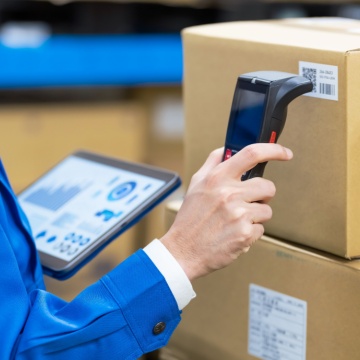Efficiency and agility are extremely important for ensuring smooth operations in warehouses. RFID is one of the latest innovations that make it easier for them to achieve these goals. Over the years, barcode technology has been used extensively for these purposes and it has evolved in recent years to give rise to RFID technology. Making use of radio waves, these systems can easily read the identification codes.
A form of wireless communication, RFID identifies objects using electrostatic or electromagnetic coupling in the electromagnetic spectrum’s radio frequency portion. It searches, identifies, tracks, and communicates with people and objects using radio frequency. Out of many different types of RFID technology devices, RFID tags are lifesavers for logistics and supply chain management. In general, RFID performs Automatic Identification and Data Capture (AIDC) function for identification of objects and data collection as well as mapping. A scanning antenna, a transponder, and a transceiver are the three major components of an RFID device.
Benefits of RFID in Logistics and Supply Chain
Logistics managers make use of RFID in multiple ways for tracking and managing their assets and products. With RFID tags and scanners, they can significantly improve the handling of products and materials, both inside and outside their warehouses.
- Product tracking: Through WMS (Warehouse Management Systems) integration, RFID can be used for tracking goods receipt, storage, and distribution. This integration allows tracking products faster, and more accurately and easily. During the arrival of goods, warehouse workers can scan the goods using RFID and add new stock in the WMS. During storage, location tracking can be enabled by scanning the product and the bin number. Also, while selecting goods, each RFID tag can be scanned by pickers and marked as outgoing.
- RFID tags are extremely useful for goods handling and route planning between different supply chain locations. RFID tags can be put on different logistics assets such as forklifts, trucks, containers, and other material handling equipment. As a result, workers can always find out the equipment’s location and retrieve it quickly for product transportation.
- It is also possible to accelerate the inventory counting and reconciliation process with the help of RFID tags and scanners. Handheld RFID devices make it a breeze to scan RFID tags. Tags are counted one by one by some scanners for every individual item. On the other hand, some others can count all tags in a location simultaneously.
- During the movement of different products, inventory managers can use RFID to track the movement and investigate if there are any discrepancies. For example, if an item is placed in the wrong location, the tag may be identified elsewhere by the RFID scanner and the user will receive an alert.
- By combining RFID’s product tracking with consumer demand information, suppliers can ensure that their products are in stock when there is a demand for the product.
- By enabling robotics and other technologies, RFID helps automate the receipt, storage, and distribution of products.
- RFID tags can also be used by suppliers to track raw materials and potentially minimise the need for reordering. This, in turn, helps optimise the manufacturing process.
At ShockWatch, we offer a range of RFID-enabled devices that can help improve your supply chain drastically. Please contact our experts today to find out more.


